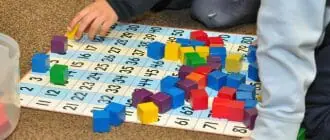Have you ever looked at your classroom library and been completely overwhelmed by the mess you see?
If you’re like many teachers, this is what you probably see: books shoved on your shelves in all directions, fiction and non-fiction all mixed together, and just a general sense of disorganization and chaos.
Fortunately, it doesn’t have to be this way. I’ve put together seven easy steps you can take to organize your classroom library and help you students truly benefit from all the books you have to offer them.

Why Reading is Important
Reading is so important for so many different reasons. The Life Formula created this video () in which they share 10 of the most important reasons that reading is important. Some of these reasons include that reading can help your brain develop and grow, increase your vocabulary, improve your focus, help you relax, and improve your memory.
Benefits of reading:
- Our brains need stimulation to continue to function at high levels. Books act as food for our brains, helping keep them stimulated and making new connections. Reading both fiction and non-fiction books can deliver these benefits. Reading can even change the structure of our brains and improve our cognitive processes.
- Another benefit students (and adults) receive when they read is a more enriched vocabulary. Books contain many words that children likely wouldn’t hear otherwise and can help them learn these words and begin to incorporate them into their daily conversations. An improved vocabulary will also help students communicate their feelings, needs, wants, and ideas more effectively. They’ll also be better equipped to add their own perspective to a conversation.
- Reading can also improve your focus and concentration. Focusing on a book when you’re reading can transfer to other areas of your life and help improve your productivity for the rest of the day.
- Another benefit of reading is that it can help improve your memory. As you follow a character in a story or remember key facts from a non-fiction text, it helps activate the memory areas in your brain. Using this area of your brain more when reading can improve your overall memory and help you in other areas of your life as well.
- Reading stories helps to open your mind. As children read about other cultures and people with different beliefs, they become more accepting of ways of life and beliefs that are different from their own.
- Reading can also help you relax. You can experience images and scenes from a book with your imagination, which can be very relaxing. Finishing a book also feels good and gives you a sense of satisfaction. Reading before bed can also help take your mind off the things that are troubling you, which can help you fall asleep faster and sleep more soundly.
As you can see, there are many benefits to reading. Providing your students with an organized classroom library where they can easily find and pick up a book that interests them can help them begin to realize more of these benefits for themselves.
Steps to Organize Your Classroom Library
Below you’ll find seven simple steps that will help you organize your classroom library. Taking the time to get your library organized with be well worth it when you see how much your students enjoy the space and how they take care to keep it organized throughout the year.
1. Decide on Your Sorting System
The first thing you’ll need to do when beginning to organize your classroom library is to decide on a sorting system. There are many different options to choose from, and there isn’t necessarily any one right approach. To help you make your decision, think about the subject(s) you teach, the ages/grade level of your students, and any preferences you have about how you’d like to sort your book.

You should first begin by separating your fiction books from your non-fiction books. Then, each of these subcategories can be sorted. You may choose to sort your books by level, genres, themes, author, or more. Again, think about the students you teach and what will make the books most easily accessible by them.
If you want to make sure your students are reading a book at their reading level, you may choose to sort your books by reading level. If you tend to plan units around different themes, you may find that sorting your books by theme works best for you.
You could also choose to do a combination of different sorting options. For example, you may level your fiction books, but sort your non-fiction books by topic to help students who are looking to learn about a specific animal, location, scientific theory, etc. If you do author studies and have a large selection of books written by different authors, you could consider leaving those books separate from your other categories too.
2. Decide on The Book Categories

After you’ve decided whether you plan to sort your books by levels, themes, or another strategy, your next task is to decide on the specific categories you will use. Having a good understanding of the books that are in your classroom library can help you get a rough idea of what these categories should be. However, you’ll likely want to have access to all of your books to do a quick sort once you believe you have your categories picked out. This will allow you to see if your categories work with the books you have and if any of your categories are lacking in books or have such a large quantity of books that it could make it too overwhelming for students who are looking for a book to find one.
After completing the first sort of your books, you may decide that you want to tweak your categories; that is completely fine. You want to make sure the categories you select will work for your students and the books you have.
3. Decide If You Want to Involve Students
Next, you’ll want to think about whether you want to involve your students in helping you organize your library. There are a few pros and cons to consider before making this decision.
A benefit of having your students help you organize your library is that they may be more likely to want to keep it organized. If they take part in sorting the books and labeling the books and see all the hard work that goes into organizing the library, it may motivate them to keep it that way.
Another benefit of involving students in the process is you can get their thoughts on how they would like the library organized and which method would work best for them. You could have it all planned out in your head, but when you ask your students their thoughts, someone may share something that makes you completely rethink what the best option for the students is.
When you involve students with organizing the classroom library, it can also help them develop organizational skills. Learning how to organize and the process involved in sorting items is an important skill that students can use throughout their life.
However, there are a few downsides to consider as well. Whenever you add more hands to a project, it can get messy. There will be more disagreements and different points of view, which could make the whole process take a lot longer.
Also, organizing a classroom library will likely take a good amount of time, which could take away instructional learning time from your students.
4. Catalog the Books

Cataloging your books so you have a record of exactly what is in your classroom library is very important. When you catalog your books, you can easily determine if you have a specific book you need for a lesson, or if you’ll need to order a copy online or check one out of the library.
If you create an electronic catalog, it will be easy to keep it updated. When you purchase new books for your library, you can just add them to your list. An electronic catalog will also be searchable, so you’ll quickly be able to determine if you have a copy of a specific book.
5. Organize and Label the Books
 After you’ve decided on your sorting system and categories and have cataloged the books in your library, you’ll want to get everything all organized. Sort your books into the various categories you decided on. Decide how you will keep your library organized. Will all of your books be going on a bookshelf? Will, you used bins or baskets to keep your books easier for your students to find? Do you have space to keep all of your books in one section of your classroom, or will you need to separate the library and have fiction books in one area and non-fiction texts in another?
After you’ve decided on your sorting system and categories and have cataloged the books in your library, you’ll want to get everything all organized. Sort your books into the various categories you decided on. Decide how you will keep your library organized. Will all of your books be going on a bookshelf? Will, you used bins or baskets to keep your books easier for your students to find? Do you have space to keep all of your books in one section of your classroom, or will you need to separate the library and have fiction books in one area and non-fiction texts in another?
Answering all the questions above can help make sure you have fully planned out the layout and organization of your library. Once you’ve decided on how you will organize your library, you’ll want to finalize exactly what you want the labels to say for each group of books.
6. Creating the Labels
Next, it will be time to actually create the labels for the different categories you finalized above. Here is one opportunity where you can choose to be creative, or you may choose to keep things simple. Either way, having one of the best label makers for teachers on hand makes this step a breeze.
You can go all-out when creating labels for your different categories of books and change fonts/colors and add images for each book, or you may choose to use just a simple printed label with the name of the category. There are also a variety of templates available online that will simplify the process of creating the labels for each book bin or section of your library.
In addition to labeling the different bins, you may also want to consider making larger labels to mark off different sections of your library. For example, if you have a fiction and non-fiction section, you can label these with a larger sign.

You could also create individual labels to go on each book. Choose a specific color or icon that corresponds with the appropriate category and mark all the books in that category with it. This will help students make sure they return the book to the correct spot and can help you perform quick checks to ensure that your library remains organized.
One final type of label you may want to add is one with your name and/or room number on it. You could put a small sticker along the spine or on the back of the book with this information on it.
This way, if one of your books gets misplaced and ends up in another part of the school or gets found by a parent, it will be able to find its way back into your library.
7. Build Student Ownership for Your Classroom Library
The final step is a crucial one if you want students to help keep your library organized and enjoy the greatest benefits from the classroom library. When you can help students feel a sense of ownership and pride in your classroom library, they’ll be more committed and invested in keeping it nice and using it.
To develop this sense of ownership, involve students in keeping the library organized. One of your rotating student jobs could be a librarian. This person could be in charge of checking that all of the books are in the correct bin where they belong.
Creating a process that students can use to ‘checkout’ books from your library can also help with building student ownership. You could give each student a slip with their name on it that they can attach to the bin that they took a book from. When they’re ready to return the book, they’ll be able to easily find the bin where it goes and get it back in the right spot.

You’ll want to set aside some time to teach your students your expectations regarding your classroom library and to help them learn routines. Providing time for students to practice these routines will help them know how to use the library and can help them feel more invested in keeping it neat and organized.
Some things you’ll want to teach include the process for checking out books, the number of books students can check out at a time, where and how books that are checked out should be stored, how to treat the books that have been checked out how to neatly return books where they belong, and what students should do if they see a book that is out of place.
Book Bins for Your Library

Using book bins rather than having your books just standing up on the shelves is key when organizing your library. Book bins make it so much easier to sort and categorize your books, and they also make it easier for your students to find where a book belongs to return it.
You can find different colors, sizes, and styles of book bins to help you organize your books in a logical way. Check out this post on the “11 Best Book Bins to Arrange a Classroom Library” you’re trying to decide which type or style of bin you’d like to purchase for your classroom library.
How to Level Your Classroom Library

Even if you only teach one grade level, it is highly unlikely that all of the students in your class are reading at the same level. There are definitely many times when it is fine, or even good, for students to read a book simply because they are interested in the topic. However, there are other times that you’ll want to make sure that your students are reading a book that is at an appropriate level for them.
Leveling your classroom library can make it possible for students to easily find books that they’ll be able to read mostly independently. This can help them improve their reading skills and help you feel more confident that they’re understanding what they’re reading and getting something out of it.
While it may seem like an overwhelming task to level your entire classroom library, it isn’t as hard as you may think. You can find many apps for Androids and iPhones that will share leveling information with you once you scan a book’s barcode. These apps don’t have information about every book you likely have in your library, but they can provide a great starting point and drastically reduce your workload. There are also numerous online resources where you can search for a book title and pull up information about the book’s level.
Here are some tools:
- Book Wizard app from Scholastic
- Level It app
- Literacy Leveler App
- Leveled Books Database
When organizing your library, you also don’t have to leave all of your books organized by level. You may choose to leave some books organized by theme. Sometimes, you may want to tell your students to choose appropriately leveled books, while at other times, you may tell them they can pick a free choice book.
Final Thoughts
Organizing your classroom library can make things so much more streamlined in your classroom. Your students will be able to easily find the books they want. When students are invested in the classroom and see the library as their responsibility too, they can help you keep it organized all year. Book bins are an essential tool for keeping a classroom library organized; read some cool articles on this site for more information on selecting the right options to meet your organizational needs.
You can also find exciting ideas for decorating your door and getting your students excited to read and learn before they even enter your classroom here.
Last Updated on July 25, 2022 by Emily
- Facebook9
- Twitter21
- Pinterest67
- 97shares




